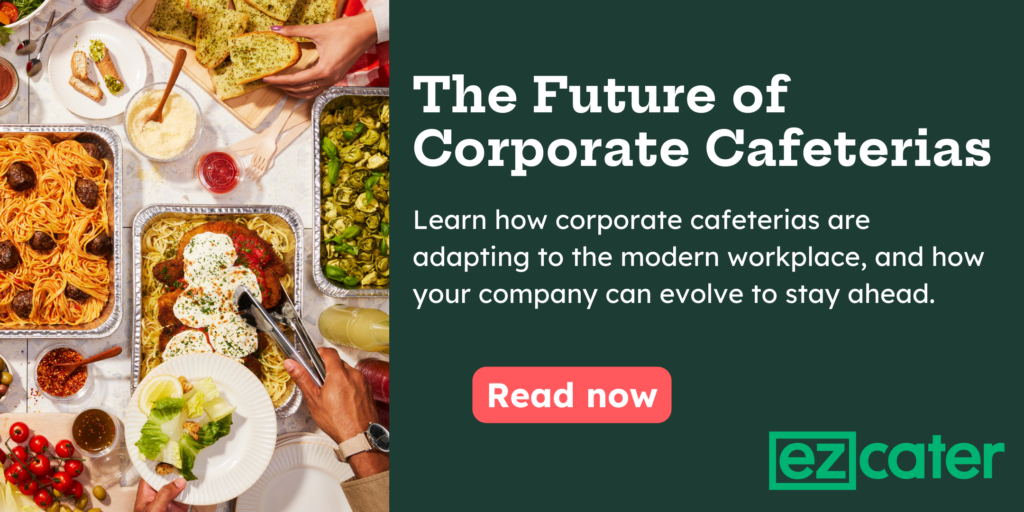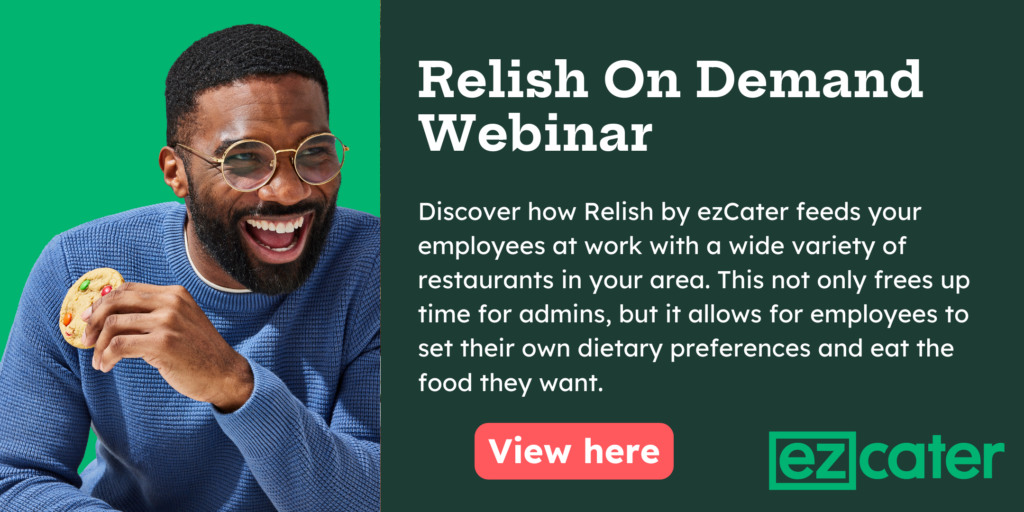For companies hoping to keep employee morale high, free food at work isn’t just a perk — it’s a priority. Fifty-seven percent of employees rate free or subsidized meals as their most-desired work benefit, and 20% of HR professionals agree that food perks offer the best return on investment (ROI).
Stats like these have led many companies to invest in on-site cafeteria plans. Despite the good intentions (and significant costs), cafeterias leave many employees feeling unsatisfied. Turns out, they’re craving a level of variety and flexibility that cafeterias can’t always deliver.
ezCater’s recent report, Why Cafeterias Aren’t Working, takes a deep dive into new survey data that reveals surprising insights about employee preferences. The survey results indicate that it may be time to consider phasing out expensive cafeteria benefits in favor of corporate cafeteria alternatives.
For the complete picture, including detailed statistics and actionable strategies, download our comprehensive report. For now, let’s explore the key reasons why employee cafeteria plans often fall flat.

What employees really want from a cafeteria plan
Based on our research, there are a few key elements that make an employee meal plan successful. Here’s a look at what your employees really want.
Healthier food
When you think of eating in a cafeteria, nutritious, wholesome meals are typically not the first thing that comes to mind. Employees agree — 37% of those surveyed say they want healthier, higher-quality food than a cafeteria plan typically offers. Burgers, sandwiches, and other cafeteria staples may be enjoyable as an occasional treat, but employees want daily meals that support their productivity and overall well-being. Options like salads, rice bowls, grilled chicken, salmon, or vegetable skewers can provide a dose of nutrients that will keep employees going all day long.
More variety
They say variety is the spice of life, and cafeterias just don’t cut it. A surprising 76% of employees with access to employee cafeteria plans say they wish they had a better variety of food options at work. So what are key decision-makers to do?

Relish by ezCater makes it easy for employers to provide individually-packaged meals from an always-exciting rotating selection of local restaurants. It’s a cost-effective way to give your employees access to everything from healthy salads to hearty Mexican dishes. Whether you’re planning an occasional employee appreciation event or providing weekly meals to staff, Relish streamlines the process, allowing each employee to choose exactly what they want.
Dietary accommodations
Food allergies and dietary restrictions are common in today’s workforce. From gluten intolerance and vegan diets to potentially life-threatening nut allergies, many employees require special accommodations. Unfortunately, cafeteria plans often struggle to meet their needs. Over half of employees find workplace cafeteria options limiting, and 41% of decision-makers acknowledge that their plans fall short.
The lack of inclusivity can leave a sizable portion of your team feeling overlooked and dissatisfied with their meal options. Since most employers adopt a cafeteria benefit to boost employee morale, this raises significant concerns.
ezCater’s user-friendly Dietary Options filter solves this problem.. With just a few clicks, you can find satisfying meals that meet specific dietary needs, improving employee satisfaction and creating a more supportive work environment.

Convenience
For many, working through lunch has become the norm. A 2023 ezCater survey found that heavy workloads and looming deadlines often force employees to skip lunch breaks. Even with a cafeteria located on-site, employees may not be able to get away long enough to enjoy a meal.
Without access to quick, nourishing meals, employees often find themselves working on an empty stomach, leading to bad moods and lower productivity. That’s bad news for everyone — but it’s nothing a quick grab-and-go meal can’t fix. Single-serving crudité platters with hummus dips, individually packaged sandwiches, and easy-to-eat savory wraps all soothe the dreaded hunger pangs without throwing a wrench into employees’ busy workdays.
“Workplaces have changed significantly in the
last 5 years. In some industries, employees are
only onsite a few days a week and their schedules
vary. To accommodate this shift, many companies
need a flexible, on-demand, and individualized
food management solution, and one that helps
them reduce their real estate footprint too.”
Ashwin Raj
Chief Executive Officer, ezCater
Flexibility
While many workplaces offer lunch between 11 a.m. and 2 p.m., not all employees want to eat at the same time. Busy schedules, changing hunger levels, and varying appetites often mean that employees find themselves feeling hungry outside of their cafeteria’s opening hours. In fact, 28% of employees cite limited hours as one of their pet peeves when it comes to a cafeteria plan.

Employee cafeteria plans are less satisfying than employers think
Despite 40% of companies reporting spending over $1 million annually on cafeteria operations, the investment really isn’t paying off. Employees’ preferences hint at higher ROIs when companies adopt alternatives to cafeteria services. In fact, seven in 10 employees say they would rather have food from local restaurants delivered to their worksite than dine on workplace cafeteria food. This makes a strong case for re-assessing food-for-work policies and considering other alternatives.

It’s clear that employees are unhappy with their cafeteria plans, but upper management often remains unaware. While 38% of decision-makers rate their cafeteria food as “excellent,” only 10% of employees agree. Even worse, 44% of employees rate the food as very poor to average.

To accommodate these preferences, consider offering grab-and-go meals, individually packaged meals, or catered trays of food left on food warmers or coolers. This gives employees the flexibility to eat when they’re actually hungry and enjoy meals when they have the time.
Make your employee meal plan count
Workplace cafeterias have been around for a long time, but they’re losing their appeal. Employees now crave alternative food services that offer more variety, flexibility, and quality. By making the right changes, companies can boost employee satisfaction and improve their return on investment.
For a deeper dive into employee preferences and innovative solutions, download our comprehensive whitepaper.








